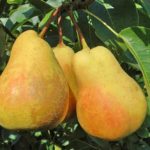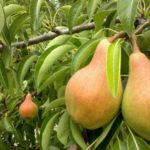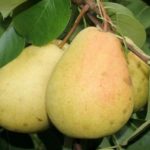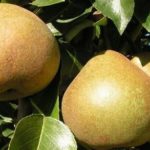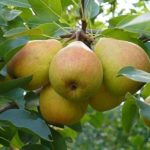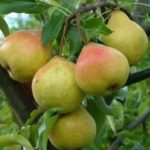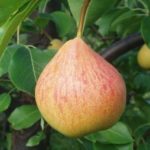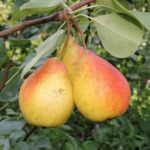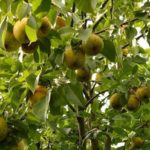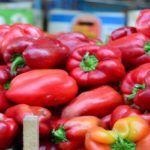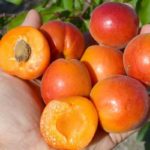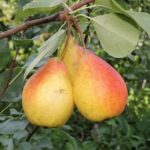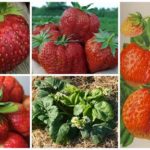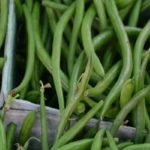Pear is a juicy fruit, imbued with the southern sun. Just a few years ago, residents of Central Russia and the northern regions could only dream of growing it in their own garden. Thanks to climate change and the work of breeders, varieties have emerged that can withstand snowy, frosty winters and not too warm and long summers. And today we will talk about the best varieties of pears for the Leningrad region.
Features of the region
The Leningrad region is characterized by short, cool summers.In spring there are not too many warm days, snow cover disappears late, autumn is rainy and protracted, winter is snowy and cold. A special feature of the region is acidic soils with small amounts of fertile layer. Nature has done everything to make this area unfavorable for growing pear trees.
To get a harvest, varieties suitable for a given region must be unpretentious, frost-resistant, early ripening, so that the fruits have time to ripen, and the trees can withstand cold and have strong immunity to infections. Therefore, even varieties of pears with mediocre taste, capable of growing in such harsh conditions, were popular with local gardeners.
The best varieties of pears for the Leningrad region
Pear tree seedlings should be purchased from reputable sellers or nurseries. Then they will correspond to the declared characteristics of the variety.
Dulya Novgorodskaya
Trees with a powerful trunk and dense crown. The variety is familiar to the North-West of Russia and is grown in the Urals. Today gardeners prefer others types of pears, with the best taste.
If the harvest is not harvested in time, the ripe fruits will crack, they will not be stored for long, and they can very loosely be called a delicious fruit dessert. Tonkovetka is planted nearby for pollination.
Tonkovetka
The variety was developed as a result of folk selection. The trees are tall, with a pyramidal crown; the characteristics of the branches give the variety its name.
The fruits are small, 50-70 grams each, a high-yielding species, pears are sour and astringent, they are not used fresh, but are suitable for preserves, jams, canning, and have a low calorie content. The fruit is yellow with a burgundy side. Fruiting begins 5-6 years after planting.
In the southern regions, Tonkovetka often grows in abandoned gardens. Dulya Novgorodskaya should be planted next to Tonkovetka for stable fruiting of trees of both varieties.
Pushkinskaya
This pear belongs to the early autumn varieties; the harvest ripens in the first ten days of September. The tree is not too tall, spreading. The fruits are small, 65-70 grams, with yellowish skin. Blushing may appear on the side. The fruit is sweet, juicy, the tree begins to bear fruit 5 years after planting.
The fruits are tasty, eaten fresh and processed. The fruits have a tart taste and make delicious compotes and jam. Planting young pears is possible in the fall (after harvest), at the end of September, so that the trees become stronger and take root before the cold weather. Or in spring (late April-May).
Variety Memory Yakovlev
An autumn type of pear, suitable for the Urals and North-Western regions. The trees are low, up to 2 meters high. The fruits are medium in size (125 grams), with thick, glossy skin. The color of the fruit is yellowish; when fully ripe, the side becomes rich red. The taste is sweet and sour, with a delicate aroma.
The tree becomes an excellent pollinator for other varieties; it can grow alone, but if there is a neighbor (for example, Lada), it significantly increases the yield.
The variety is suitable for processing. The fruits are dried, canned, and jam is made.
Severyanka
Winter-hardy variety. The trees are tall, with a dense pyramidal crown. The fruits are medium in size, from 90 to 120 grams. The hue of pears is yellow-green, upon reaching full ripeness it becomes golden, the side of the fruit turns pink. The fruits are juicy, with sweet pulp, creamy in color. Having reached full maturity, they quickly fall off.
Severyanka is grown in the Urals, Leningrad and Novgorod regions. The young tree begins to bear fruit 4 years after planting.
The fruit is resistant to the codling moth and pear mite. Severyanka is not grown in nurseries today; new varieties have been created on its basis.
The successes of breeders make it possible to grow tasty fruits in different regions of the country. The main thing is to choose zoned varieties and properly care for the seedlings.


